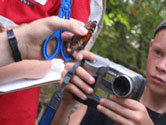 |
|
|
For more insect-related lesson plans and activities, visit my
|



This problem-based learning unit was developed as a part of the Illinois Math & Science Partnerships project funded through a grant from the Illinois Board of Education.
| Back to Top |
Students will need to have prior experience with identifying common Illinois butterflies. You may choose to limit your survey to a few easy-to-identify species in order to expedite the survey process and reduce possible errors in data collection. An introductory PowerPoint presentation, field guide cards, and flash cards have been provided to help your students learn how to identify the 25 species listed on the Illinois Butterfly Monitoring Network Beginner’s List as well as a few from the intermediate category. | Back to Top |
Primary Career Pathway: Natural Resources Systems
Cluster Knowledge and Skills and Performance Elements addressed: | Back to Top | The local board of the US Fish and Wildlife Service wants to increase the biodiversity of the butterfly population within Chautauqua Wildlife Refuge. Your task, as refuge manager, is to recommend a strategy to increase the diversity of the butterfly populations at this site. | Back to Top |
Develop a procedure to conduct a butterfly survey | Back to Top |
Butterfly Boot Camp - I use these presentations as class warm-ups for a two-week period prior to the scheduled field trip. The presentations introduces students to butterflies commonly found in our area and provides quick quizzes. In addition, flash cards and field ID guides are available. The students use the flash cards during class or study hall to practice their identification and are able to refer to the field guides during the survey field trip.
Lesson #1: Biodiversity Basics Student Worksheet: Biodiversity of Illinois ALSO AVAILABLE for educator's outside Illinois ... The Wild Classroom Biodiversity worksheet to use with their biodiversity video.
Lesson #2: Butterfly Problem Student Worksheet: Butterfly Problem
Lesson #3: Name That Butterfly Resources: Lesson 3 Overview, Butterfly Flash Cards
Lesson #4: Survey Field Trip Resources: Lesson 4 Overview, Survey Data Page, Butterfly Field Guide
Lesson #5: Data Analysis Part 1
Resources: Lesson 5 Overview & Data Analysis Part 1 Worksheet
Lesson #6: Data Analysis Part 2 & Final Reports
Resources: Lesson 6 Overview and
Data Analysis Part 2 Worksheet | Back to Top | Websites
Butterflies & Moths of
North American Butterfly Association - http://www.naba.org/ Links for students can be found in the Plants & Animals section of the Kid Zone. Printed Resources
Field Guide to Butterflies of
Butterflies through Binoculars – Available through most bookstores
Golden Guide: Butterflies & Moths – Available through most bookstores Curriculum Resources Biodiversity Basics – Available from the Illinois Department of Natural Resources Curriculum Guide - Available at https://www.dnr.illinois.gov/education/Pages/BioBasics.aspx. The video guide and lessons are included in the Supplemental Information section. Biodiversity of Illinois Video - Available at https://www.youtube.com/watch?v=2rBjPpTtzIo&feature=youtu.be . Teachers may also request a copy of the Exploring Illinois' Natural Resources DVD, which contains the video and videos from other DNR educational programs. | Back to Top | | Back to top |
|
|
|
Privacy Policy © 1999-2025 sciencespot.net |
The Science Spot was developed in March 1999 by
Tracy
Tomm, former Science Teacher @
Havana Junior High, Havana, IL. Activities,
lessons, & worksheets available on
any page of this web site are
intended for use by a single teacher
in his/her classroom or to share at
educational conferences. Reproduction for commercial use or
profit is not permitted without the
consent of
Tracy (Trimpe) Tomm. Visit my
Frequently Asked Questions page for more details. |




